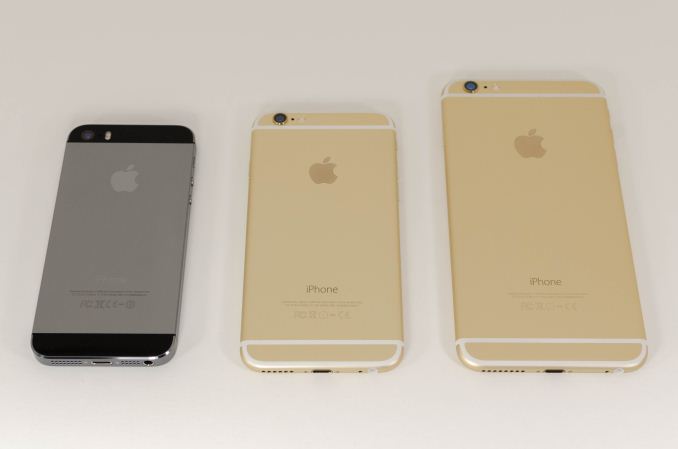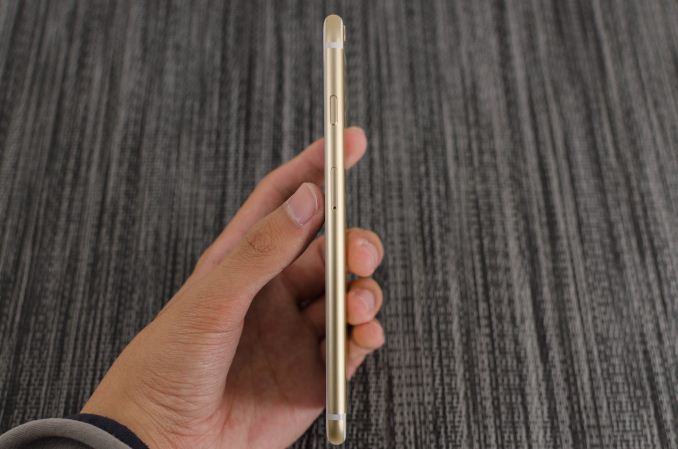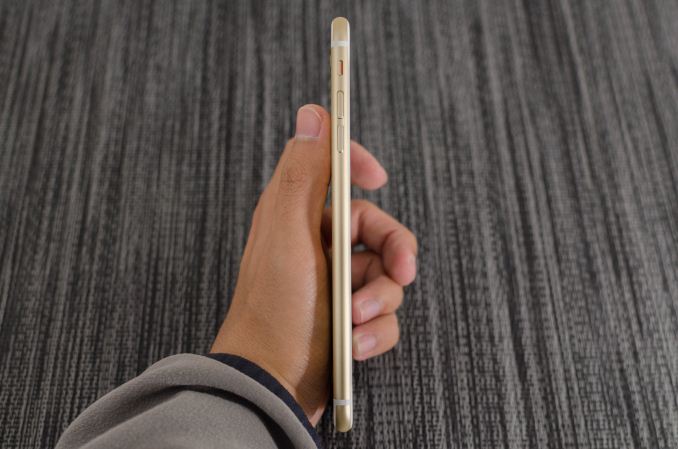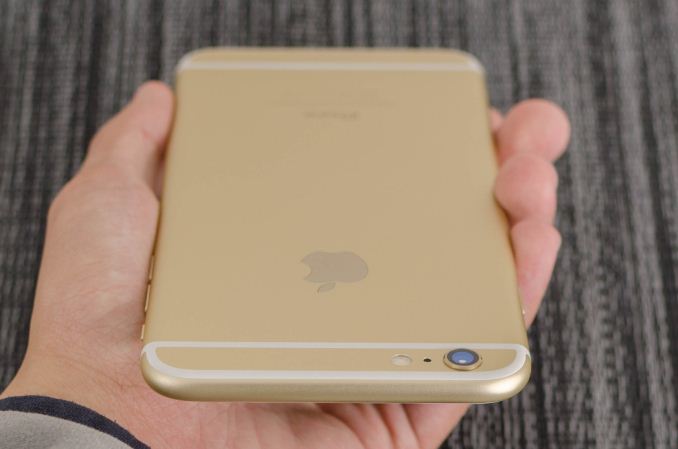The iPhone 6 Plus Mini-Review: Apple's First Phablet
by Joshua Ho on September 30, 2014 8:00 AM EST- Posted in
- Smartphones
- Apple
- Mobile
- iOS
- iPhone 6 Plus

While we’ve also written about the iPhone 6, the iPhone 6 Plus needs its own review in order to really understand the various features of the device that would otherwise be buried in the context of the iPhone 6. Without question, this device represents a significant departure from the way Apple has competed in the smartphone space. Until now, Apple hasn't competed in the phablet space and has thus avoided competing with Galaxy Note line that has been established as the dominant phablet for the past 3-4 generations. As a result, Apple occupies a fast-follower position at best.
This brings us to the iPhone 6 Plus, which really is an extension of the iPhone 6. Both phones share the same SoC, NAND configurations, front and rear camera sensors, LED flash module, industrial/material design, TouchID home button, earpiece and speaker configuration, WiFi/BT chipset, modem, and button layout. At this point, I’m going to stop listing similarities because the iPhone 6 Plus is interesting for its differences. Unlike similarities, the differences are simple. The iPhone 6 Plus is bigger, the display has higher pixel density, the camera has optical image stabilization, and iOS 8 has new app designs to take advantage of the larger screen. The iPhone 6 Plus is also more expensive, with the 16GB version starting at the same price as the 64GB version of the iPhone 6.
While I’ve already discussed the design of the iPhone 6, it’s important to see whether the same design translates to the iPhone 6 Plus. To this end, the iPhone 6 Plus does well. While the angular design of the iPhone 5 line would have looked and felt enormous in the hand, the shape is quite similar to the iPad line and is similarly comfortable in the hand, although the rounded edge really differentiates it, as does the control scheme. The only real issue here is that the top bezel on the front becomes surprisingly large, and this seems to contribute to a sense that the phone is top-heavy even though the phone is evenly balanced.
| Apple iPhone 5s | Apple iPhone 6 | Apple iPhone 6 Plus | |
| SoC | Apple A7 | Apple A8 | Apple A8 |
| Display | 4-inch 1136 x 640 LCD | 4.7-inch 1334 x 750 LCD | 5.5-inch 1920 x 1080 LCD |
| WiFi | 2.4/5GHz 802.11a/b/g/n, BT 4.0 | 2.4/5GHz 802.11a/b/g/n/ac, single stream, BT 4.0, NFC | |
| Storage | 16GB/32GB/64GB | 16GB/64GB/128GB | 16GB/64GB/128GB |
| I/O | Lightning connector, 3.5mm headset | ||
| Size / Mass |
123.8 x 58.6 x 7.6 mm, 112 grams |
138.1 x 67 x 6.9 mm, 129 grams |
158.1 x 77.8 x 7.1 mm, 172 grams |
| Camera |
8MP iSight with 1.5µm pixels Rear Facing + True Tone Flash 1.2MP f/2.4 Front Facing |
8MP iSight with 1.5µm pixels Rear Facing + True Tone Flash 1.2MP f/2.2 Front Facing |
8MP iSight with 1.5µm pixels Rear Facing + True Tone Flash + OIS 1.2MP f/2.2 Front Facing |
| Price |
$99 (16GB), $149 (32GB) on 2 year contract |
$199 (16GB), $299 (64GB), $399 (128GB) on 2 year contract |
$299 (16GB), $399 (64GB), $499 (128GB) on 2 year contract |
Overall, even though the iPhone 6 Plus is noticeably taller than the Galaxy Note 3 both feel similar in size. The iPhone 6 Plus is on the thinner side which makes a significant impression in the hand. At any rate, it’s physically impossible for me to use this device with one hand for most situations. It’s definitely a tablet in this sense, but in a much more compact and pocketable form factor.
"Bendgate"
Of course, drawing the comparison between the iPhone 6 Plus and Galaxy Note 3 inevitably raises the question of “bendgate”, which draws interesting parallels with “scuffgate” from the iPhone 5 generation. Unfortunately, I can’t destroy multiple review units in order to thoroughly investigate this issue. However, we can look at Consumer Reports’ data and come to a few conclusions about this problem. The first is that in the case of the iPhone 6 Plus, there appears to be an area near the bottom of the volume buttons that is a weak point as we see a clear failure of the casing in this area.
However, it seems that there is a significant amount of force needed in the first place in order to cause permanent deformation. Otherwise, everything that we’ve seen is primarily the result of fundamental differences between the two materials. It’s clear that in the case of the Galaxy Note 3 that a great deal of the structural rigidity is tied to the display itself, so the case doesn’t quite provide much in the way of protection as the polymer used is clearly in the elastic region all the way to failure. LG seems to have a different design though, as their polymer material has a clear case of brittle failure at the limit, which saved the display from shattering.
It's certainly possible to bend the iPhone 6 Plus (or really any phone or tablet), but the real issue here that hasn’t been addressed is the level of force needed to cause a certain level of elastic or plastic deformation in the material. This matters far more when discussing drop protection as the level of force in such a scenario is relatively small but applied over an extremely short period of time. There’s also no mention of force per unit area in any of these figures, so we can’t really have a serious discussion about this issue without the necessary data.














191 Comments
View All Comments
Parhel - Tuesday, September 30, 2014 - link
A manufactured scandal if ever there was one. Just wait until the "will it blend" videos start popping up. Then we can have blendergate.joe_dude - Tuesday, September 30, 2014 - link
I'm looking for real test results, not conjecture. Anandtech could settle the issue by doing a 4 point test along the buttons. I'm guessing it bends at that spot with just 30 to 40 lbs. of force. Generic performance and battery tests, any review site can do. This is Anandtech, so I expect more in terms of technical nitty-gritty.yofa42 - Tuesday, September 30, 2014 - link
+1Parhel - Tuesday, September 30, 2014 - link
They plainly stated in the article, if you care to read it, that they're not going to destroy phones for the purpose of this review. So you'll have to get your "technical nitty-gritty" elsewhere.The link you posted is disingenuous. It's astroturfing, a "viral marketing" advertisement.
joe_dude - Tuesday, September 30, 2014 - link
Oh please. Joshua simply glossed over the issue without mentioning the video that started the whole #bendgate debate. Give us some hard numbers to show whether there really is a weak spot that would be prone to bending. Many people want to know if it really is an issue. Anandtech should help settle it once and for all. That's what Anandtech is supposed to be about - products that are thoroughly reviewed!Alexey291 - Tuesday, September 30, 2014 - link
Nah all we're getting now is engadget style clickbait reviews with predictable (aka forced) conclusions.I am betting that every device (unless its REALLY crap) will get the same kind of "its the best device to buy right now" conclusion.
Because you know... Anandtech's looooong since sold out.
Parhel - Wednesday, October 1, 2014 - link
It's hard to find a single review on Anandtech where somebody doesn't accuse them of being paid off. Doesn't matter if it's a hard drive, a video card, a phone, an OS. There's always somebody ready to make a baseless accusation without any evidence. That's the Internet for you. It's made everybody an expert in everything.But, you know, some guy on Youtube bending iPhones . . . that's a guy we can all trust, right? I've seen the videos too. I wouldn't buy a car from that guy, I can tell you that.
OreoCookie - Thursday, October 2, 2014 - link
For a scientifically conclusive test, you need to destroy tens of iPhones. That's an investment of a five-digit amount. Moreover, if AnandTech's phone is a review unit, they need to return it -- intact. Consumer report has at least quantified the force it takes to bend and break for a single phone and, important point, compared that to other phones. The tested iPhones 6 and 6+ were more robust than an HTC One M8, a phone for I have yet to see a report that it has a propensity for bending and breaking. Every single year the tech press finds something wrong with iPhones (e. g. the iPhone 4's antenna), to the degree that much more significant problems (e. g. the botched iOS 8.0.1 update) disappear in the bendghazi cacophony.InTheBoilerRoom - Tuesday, September 30, 2014 - link
Is there a particular reason that the Nokia Lumia 930 and 1020 were not included in the camera comparisons for the iPhone 6 and 6+? You have results for both (posted in the 920 review) and those are much more relevant benchmarks than the other phones included. I'm more interested in how close Apple's cameras are getting to the class leaders than to middle of the road phone cameras.underseaglider - Tuesday, September 30, 2014 - link
Apple has always set the bar to the highest when it comes to their models. They always make sure they come up with the first of its kind and iPhone 6 has been creating buzz even it was questioned with its bendability.